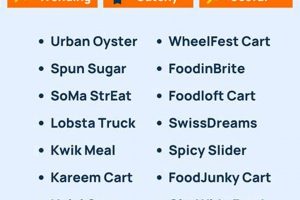Clearly visible visual communication displayed on mobile food vending vehicles serves as a primary means of attracting customers. This encompasses a broad range of mediums, from simple painted lettering to complex, digitally printed graphics and illuminated displays. For example, a brightly colored display featuring an appetizing image of a signature dish, coupled with easily readable pricing, immediately communicates the food truck’s offerings to passersby.
Effective mobile vendor signage plays a pivotal role in establishing brand identity, increasing customer awareness, and ultimately driving sales. Historically, these displays were often hand-painted, reflecting a more artisanal approach. However, modern advancements in printing and lighting technologies allow for greater design flexibility, durability, and visibility, enabling businesses to create highly impactful advertisements. Benefits include attracting attention in crowded locations, communicating menu offerings, and establishing a professional image.
Understanding the various aspects of design, materials, regulations, and best practices is crucial for optimizing the impact of mobile food vendor displays. Subsequent sections will delve into these topics, providing a comprehensive guide for creating effective and compliant visual communication strategies.
Essential Considerations for Mobile Food Vendor Displays
Optimizing visual communication on mobile food vending vehicles requires careful attention to detail. The following guidelines offer strategies for creating effective and compliant displays.
Tip 1: Prioritize Legibility: Font selection and size are paramount. Choose a clear, easily readable font that contrasts sharply with the background color. Ensure lettering is large enough to be read from a reasonable distance, accounting for viewing angles and potential obstructions.
Tip 2: Maintain Brand Consistency: Integrate the business’s established logo, color palette, and overall branding aesthetic into the display design. This reinforces brand recognition and helps customers identify the mobile vendor quickly.
Tip 3: Emphasize Key Menu Items: Highlight signature dishes or daily specials prominently. Consider using high-quality images or illustrations to visually represent the offerings and entice potential customers.
Tip 4: Adhere to Local Regulations: Research and comply with all local ordinances regarding size restrictions, placement limitations, and illumination requirements for mobile vendor signage. Non-compliance can result in fines or permit revocation.
Tip 5: Select Durable Materials: Given the exposure to weather and the rigors of transportation, opt for durable, weather-resistant materials. Consider options such as aluminum composite, vinyl banners, or digitally printed graphics with UV protection.
Tip 6: Optimize Illumination: If operating during evening hours, incorporate effective illumination. Options include LED lighting, backlit displays, or external spotlights. Ensure the lighting is bright enough to enhance visibility without being overly glaring or distracting.
Tip 7: Consider Placement Strategically: The placement of the display is critical. Maximize visibility by positioning it in a location that is easily seen by pedestrians and vehicular traffic. Consider utilizing multiple displays on different sides of the vehicle.
Employing these strategies will increase the likelihood of attracting customers and maximizing the impact of mobile food vending vehicle displays.
The subsequent section will discuss common challenges and potential solutions related to mobile food vendor displays.
1. Visibility
The effectiveness of mobile food vendor displays hinges critically on visibility. Maximizing visibility ensures that the mobile vendor attracts attention from potential customers, increases brand awareness, and ultimately drives sales. Multiple facets contribute to optimizing the visibility of these displays.
- Strategic Placement
Placement is a foundational element in enhancing visibility. Positioning the mobile food vending vehicle in high-traffic areas, such as near popular events, busy intersections, or commercial districts, increases the number of potential customers who will see the displays. Careful consideration of sightlines, potential obstructions, and pedestrian flow is crucial. A mobile vendor positioned behind a large building or obscured by trees will have significantly reduced visibility, regardless of the quality of the visual communication.
- Effective Illumination
Illumination plays a vital role, particularly during evening hours and in low-light conditions. Well-lit displays attract attention and ensure that the mobile food vendor remains visible and appealing. The use of LED lighting, backlit displays, or strategically placed spotlights can significantly enhance visibility without being overly glaring or distracting. Illumination should be consistent and reliable, ensuring that the display remains visible throughout the mobile vendor’s operating hours.
- Contrasting Colors and Bold Graphics
The selection of colors and the design of graphics directly impact visibility. Using contrasting colors for the background and lettering ensures that the display is easily readable from a distance. Bold graphics and clear, concise messaging capture attention and communicate the mobile vendor’s offerings effectively. Overly complex designs or muted colors can reduce visibility and make it difficult for potential customers to quickly understand the mobile vendor’s brand or menu.
- Sign Size and Height
The physical dimensions of the mobile food vendor display, including both size and height, greatly impact its visibility. Larger displays are generally more visible than smaller ones, particularly in crowded environments. The height at which the display is positioned also plays a crucial role. Raising the display above potential obstructions, such as parked cars or pedestrian traffic, enhances visibility and ensures that it can be seen from a greater distance. However, the size and height of the display must adhere to local regulations to avoid potential fines or permit revocation.
The multifaceted nature of visibility necessitates a comprehensive approach to mobile food vendor display design. By strategically positioning the vehicle, employing effective illumination, utilizing contrasting colors and bold graphics, and adhering to appropriate sign size and height regulations, mobile food vendors can maximize the visibility of their displays, attracting a larger customer base and increasing overall business success.
2. Legibility
The effectiveness of visual communication on mobile food vending vehicles is directly correlated with legibility. If potential customers cannot easily read the information presented on the display, regardless of the aesthetic appeal or strategic placement, the communication fails. This deficiency results in lost sales opportunities and reduced brand recognition. For example, a food truck specializing in gourmet sandwiches might employ an elaborate font that, while visually interesting, is difficult to decipher at a glance. This impedes the potential customer’s ability to quickly ascertain the truck’s offerings, leading them to patronize a more readily understood competitor. The core function of food truck signage, therefore, depends upon prioritizing clear, easily readable typography.
Consider the practical application of this understanding. Implementing a sans-serif font, such as Arial or Helvetica, typically provides optimal legibility, particularly when viewed from a distance or while in motion. Furthermore, careful consideration must be given to the contrast between the font color and the background. A light-colored font against a dark background, or vice versa, ensures maximum readability. Improper color choices diminish the displays communicative impact. For instance, using a pale yellow font on a white background renders the display practically invisible, negating any potential positive effect the sign might otherwise have.
In summary, legibility constitutes a foundational element of successful mobile food vendor displays. Failure to prioritize clear typography and adequate contrast between font and background undermines the effectiveness of the signage and diminishes the potential for attracting customers. Addressing legibility challenges requires a pragmatic approach, emphasizing simple, easily readable fonts and high-contrast color schemes. This seemingly simple yet crucial aspect significantly impacts the overall success of a mobile food vending business.
3. Branding
The visual communication displayed on a mobile food vending vehicle is inextricably linked to its overall brand identity. Displays are not merely advertising mediums but integral components of brand representation, shaping customer perceptions and influencing purchasing decisions. The success of a mobile food vendor often hinges on the ability to cultivate a recognizable and appealing brand, and the signage serves as a critical tool in achieving this objective.
- Logo Integration
The consistent and prominent display of a business’s logo is fundamental to brand recognition. The logo should be strategically incorporated into the overall design, ensuring it is easily visible and reinforces the brand identity. For example, if a food truck’s logo features a stylized image of a taco, this image should be consistently used across all marketing materials, including the signage, to create a cohesive brand image. Failure to prominently display the logo weakens brand recognition and diminishes the overall impact of the branding efforts.
- Color Palette Consistency
The selection and consistent application of a specific color palette is critical to establishing brand recognition. Colors evoke emotions and associations, and a well-defined color palette can create a strong brand identity. For instance, a food truck specializing in organic and healthy foods might opt for a color palette of greens and browns to convey a sense of naturalness and authenticity. Inconsistent use of colors can confuse customers and weaken the brand’s message. A consistent color scheme, across all marketing materials, promotes brand recall and loyalty.
- Messaging and Tone
The language and tone used in the display directly reflect the brand’s personality and values. Concise, engaging messaging that resonates with the target audience is crucial. If a food truck aims to project a fun and playful image, the signage might incorporate humorous slogans and lighthearted graphics. Conversely, a food truck targeting a more sophisticated clientele might opt for elegant typography and minimalist designs. Inconsistent messaging or a tone that clashes with the brand’s overall identity can confuse customers and undermine the brand’s credibility. Clearly defined messaging, aligned with target audience, enhances positive customer experience.
- Visual Style and Imagery
The overall visual style and imagery used in the display contribute significantly to brand perception. The style and visuals must consistently reflect the brand’s identity. For a food truck specializing in gourmet burgers, high-quality images of the burgers, showcasing their visual appeal, is essential. A visual style that is inconsistent with the brand’s offerings or that appears unprofessional can deter potential customers. A visual style aligned with brand personality ensures enhanced perception.
In conclusion, the visual elements of a mobile food vendor display are not merely decorative but serve as a vital extension of the brand. Consistent logo usage, deliberate color choices, tailored messaging, and thoughtfully selected imagery work together to communicate the brand’s identity and values. By integrating these branding elements effectively, mobile food vendors can create memorable and compelling displays that attract customers and build brand loyalty. The display acts as a constant visual reinforcement of the brand, contributing to sustained business success.
4. Materials
The selection of materials directly impacts the longevity, visibility, and overall effectiveness of displays on mobile food vending vehicles. The harsh outdoor environment necessitates materials that withstand varying weather conditions, including intense sunlight, rain, wind, and temperature fluctuations. Substandard materials degrade rapidly, leading to faded colors, warped surfaces, and eventual structural failure. A food truck operating in a region with high UV exposure, for example, would require materials with UV-resistant coatings to prevent premature fading of graphics and text. The choice of materials, therefore, is a crucial determinant of the display’s ability to effectively communicate the brand and attract customers over an extended period. Failure to consider environmental factors during material selection invariably leads to increased maintenance costs and the need for frequent replacements.
The impact of material choice extends beyond durability. The type of material employed affects the quality of printed graphics, the effectiveness of illumination, and the ease of maintenance. For instance, while vinyl banners offer a cost-effective solution for temporary displays, they may lack the rigidity and visual impact of more robust materials like aluminum composite panels. Illuminated signs constructed from acrylic or polycarbonate provide superior light diffusion compared to less expensive alternatives, resulting in a more visually appealing and easily readable display at night. The weight of the material also presents a practical consideration, influencing installation complexity and potential impact on vehicle fuel efficiency. Careful consideration must be given to balancing cost, durability, visual appeal, and ease of use when selecting materials for displays on mobile food vending vehicles. Real-world examples, such as examining the difference in visual impact between digitally printed vinyl and professionally painted aluminum, illustrate the impact. The ability to clean is also important; some material may stain more easily than others.
Ultimately, material selection represents a strategic decision with significant implications for the success of a mobile food vending business. While cost considerations are unavoidable, prioritizing durability and visual quality ensures a worthwhile investment that strengthens brand identity, attracts customers, and minimizes long-term maintenance expenses. Addressing challenges related to material selection requires a thorough understanding of environmental conditions, material properties, and printing technologies. Recognizing the practical significance of these factors empowers food truck owners to make informed decisions that optimize the impact and lifespan of their displays, thereby contributing to a more professional and successful operation. The interplay between materials, environmental factors, and the intended visual impact determines the effectiveness of these important brand tools.
5. Regulations
Compliance with local, state, and federal regulations is a critical consideration in the design, fabrication, and placement of displays on mobile food vending vehicles. These regulations often dictate permissible display sizes, illumination levels, and placement restrictions, significantly impacting the visual communication strategies employed by food truck operators. Failure to adhere to these regulations can result in fines, permit revocation, and potential legal action, hindering the operation of the business. For example, many municipalities restrict the overall height of signage to ensure it does not obstruct traffic visibility or impede pedestrian access. Therefore, understanding and complying with these restrictions is a prerequisite for legal and effective display utilization.
The interplay between regulations and display design is multifaceted. Municipalities often establish specific zones where mobile vending is permitted, with varying regulations regarding signage within each zone. A commercial district might allow larger, illuminated displays, while a residential area might impose stricter limitations on size and illumination to minimize light pollution and visual clutter. Furthermore, health codes often mandate specific information to be prominently displayed, such as allergen warnings, nutritional information, and operating permits. Therefore, display designs must not only be visually appealing but also accommodate legally required information in a clear and legible manner. Ignoring the impact of geographical zoning or health and safety requirements on display content or location can have serious legal ramifications.
In summary, navigating the regulatory landscape is essential for successful food truck display implementation. The design process must incorporate a thorough understanding of applicable regulations to ensure compliance and avoid costly penalties. Prioritizing regulatory compliance not only protects the business from legal repercussions but also demonstrates a commitment to responsible operation, enhancing the business’s reputation and fostering positive relationships with the local community. The practical significance lies in safeguarding business operations and contributing to a harmonious coexistence with the surrounding environment.
6. Illumination
Illumination plays a crucial role in enhancing the visibility and effectiveness of displays on mobile food vending vehicles, particularly during evening hours and in low-light conditions. Insufficient illumination renders displays largely ineffective, negating the impact of design elements and messaging. Displays, regardless of their aesthetic appeal or strategic placement, become practically invisible after dark without proper lighting. For example, a food truck operating in a dimly lit urban environment relies heavily on illuminated signage to attract customers. Effective illumination transforms the display from a static visual into an eye-catching beacon, increasing visibility and attracting attention from passersby.
The specific type of illumination employed significantly impacts the overall effect. Options range from traditional incandescent bulbs to energy-efficient LED lighting and internally lit display panels. LED lighting has become increasingly prevalent due to its energy efficiency, long lifespan, and ability to produce vibrant and consistent light. Backlit displays, where the light source is positioned behind the graphic, create a uniform and attention-grabbing effect. External spotlights can highlight specific elements of the display, drawing attention to key menu items or branding elements. In contrast, poorly chosen illumination can create glare, distort colors, or appear uneven, diminishing the display’s appeal. The choice of color temperature is also a factor, as cooler temperatures can enhance brand perception. A poorly chosen color will diminish customers.
Effective illumination is a crucial investment for mobile food vendors seeking to maximize their visibility and attract customers, thus directly translating into the potential for increased revenue. Furthermore, strategically designed lighting schemes contribute to the overall aesthetic and brand identity of the food truck, reinforcing its image and creating a more inviting atmosphere. In summary, properly implemented illumination is a fundamental aspect of successful display strategies on mobile food vending vehicles. Addressing challenges related to lighting selection, placement, and maintenance is essential for ensuring long-term effectiveness and optimizing the return on investment. Its visual and branding effect is not negligible.
7. Placement
The geographical positioning of mobile food vending vehicle displays is intrinsically linked to their efficacy. Optimal placement maximizes visibility, attracting attention from potential customers and directly influencing sales volume. Suboptimal placement, conversely, renders even the most aesthetically pleasing and informative displays ineffective. For example, a display positioned in a low-traffic area or obscured by obstructions will fail to reach a significant segment of its intended audience. Therefore, placement decisions represent a critical determinant of display performance and overall business success.
Evaluating placement necessitates a multifaceted approach, considering factors such as pedestrian and vehicular traffic patterns, visibility from various vantage points, proximity to target demographics, and local regulations governing mobile vending operations. Securing a location near a popular event, a busy intersection, or a commercial district can significantly increase exposure. However, compliance with zoning ordinances and parking regulations remains paramount. Furthermore, the competitive landscape warrants consideration. Locating near similar food vendors may increase overall foot traffic but simultaneously intensifies competition for customer attention. A strategic assessment of these variables enables informed placement decisions, maximizing the impact of displays and minimizing potential disadvantages.
In conclusion, the placement of displays on mobile food vending vehicles is a strategic imperative, directly influencing visibility, customer engagement, and ultimately, revenue generation. Careful consideration of traffic patterns, regulations, and the competitive environment is essential for optimizing display performance. Effective placement transforms a static visual into a dynamic marketing tool, contributing to a thriving and sustainable mobile food vending business.
Frequently Asked Questions
The following questions address common inquiries and misconceptions regarding visual communication strategies for mobile food vending businesses. Understanding these aspects is crucial for maximizing the impact of displays and ensuring compliance with relevant regulations.
Question 1: What materials are best suited for mobile food vending vehicle displays?
Durability and weather resistance are paramount. Common options include aluminum composite panels, vinyl banners (for temporary use), and digitally printed graphics with UV protection. The selection should consider local climate conditions and budget constraints.
Question 2: How can visibility be maximized, particularly during evening hours?
Strategic illumination is key. LED lighting, backlit displays, and external spotlights can enhance visibility without causing glare. The intensity and color temperature of the lighting should be carefully considered.
Question 3: What role does branding play in the design of displays?
Displays should consistently reflect the business’s brand identity, including logo, color palette, and overall visual style. Consistent branding reinforces recognition and fosters customer loyalty.
Question 4: What regulations typically govern the size and placement of mobile vendor signage?
Local municipalities often regulate display size, height, and proximity to roadways. Compliance with zoning ordinances and building codes is essential to avoid fines or permit revocation.
Question 5: Why is legibility such a crucial consideration?
If the information on the display is not easily readable, it will fail to attract potential customers. Font selection, size, and color contrast must be carefully considered to ensure optimal legibility from a distance.
Question 6: What are the potential consequences of non-compliance with signage regulations?
Non-compliance can result in fines, permit suspension or revocation, and potential legal action. Understanding and adhering to all applicable regulations is crucial for operating a mobile food vending business legally and successfully.
Understanding the nuances of visual communication strategy, including materials, visibility, branding, regulations, and legibility, is paramount for any successful mobile food vendor. Prioritizing these considerations will yield measurable results.
The subsequent section will provide a comprehensive checklist for designing effective displays.
Mobile Food Vendor Visual Communication
The preceding examination of mobile food vendor displays underscores the critical role of visual communication in the success of these enterprises. Strategic consideration of materials, legibility, visibility, branding, regulatory compliance, and optimal placement is not merely a matter of aesthetic enhancement, but rather a foundational element of effective marketing and customer acquisition. These displays represent a direct point of contact with potential patrons, conveying information, establishing brand identity, and ultimately driving sales.
The evolution of food truck enterprises necessitates a continued emphasis on impactful display strategies. Businesses are encouraged to prioritize informed design, rigorous adherence to regulations, and a commitment to crafting displays that resonate with their target audience. The displays remain a vital instrument in cultivating recognition and building a loyal customer base.







